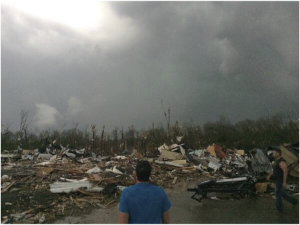| Section |
|---|
| Column |
|---|
IntroductionThis page describes two studies of different convective cases; one over N. America associated with formation of severe tornadoes, the other over central Africa. The N.America case has strong large scale forcing whereas the central African case is driven by the diurnal cycle. Both cases are studied starting the forecast from the same date/time (initial conditions). In these case studies, you will carry out a control forecast, followed by any number of suggested sensitivities experiments. US Tornado convection case (Arkansas) On the 27 April 7pm local time (00UTC 28 April), tornadoes hit towns north and west of Little Rock, Arkansas killing approx 17 people. (http://edition.cnn.com/2014/04/28/us/severe-weather/index.html?hpt=hp_c2). On the evening on the 28 April fatal tornadoes occurred over Mississippi (http://www.bbc.co.uk/news/world-us-canada-27199071). This case study will look at the role of convection and the large scale in these events.
More information can also be found on the ECMWF Severe Event Catalogue 201404 - Convection - Arkansas U.S.
| Panel |
|---|
| borderColor | white |
|---|
| bgColor | white |
|---|
| titleBGColor | white |
|---|
|   |
African diurnal deep convection (Central Africa)Over tropical land masses, incoming radiation strongly heats the surface leading to the development of deep convection and precipitation. Observations show that convective activity and precipitation peak in the late afternoon or early evening. Until very recently numerical weather prediction models struggled to reproduce this diurnal cycle, often predicting convection to peak too early in the day. In this case study, aspects of the convective parameterization scheme can be altered to see how the intensity and the diurnal cycle of convection responses. |
| Column |
|---|
| Panel |
|---|
| bgColor | white |
|---|
| titleBGColor | #dcf0f7 |
|---|
| borderStyle | dotted |
|---|
| title | On this page... |
|---|
| |
|
|
Initial conditions
...
Case study initial conditions for this case study are provided on the OpenIFS ftp site.
The initial conditions are available at a range of different resolutions and start dates for a 30hr forecast. The experiment ids are created at ECMWF and used for identifying the model forecasts on the ECMWF archive system (for those with access).
Note that ERA-Interim has a resolution of T255.
| Info |
|---|
As OpenIFS is a spectral model, the 'T' number refers to the triangular truncation in spectral space. Equivalent grid resolutions are:
T159 ~ 125km resolution, T255 ~ 80km, T511 ~ 40km, T799 ~ 25km, T1279 ~ 16km. |
TODO: table of data to download
Download instructions
| Code Block |
|---|
|
% mkdir -p runs/convection/t255
% cd runs
% ftp ftp.ecmwf.int
ftp> cd case_studies/lothar_storm
ftp> binary
ftp> get 1999122412_T159_fqar.tgz
ftp> quit
% tar zxf 1999122412_T159_fqar.tgz
% ls
1999122412_T159.tgz ICMCLfqarINIT ICMGGfqarINIT ICMGGfqarINIUA ICMSHfqarINIT ecmwf
% ls ecmwf
NODE.001_01 namelistfc |
The 'ecmwf' directory contains the files produced at ECMWF when this experiment was run:
- namelistfc : copy this file to 'fort.4' to run the experiment (modify as required)
- NODE.001_01 : this is the model output file as run at ECMWF. If your run fails, it may be useful to compare with this file.
Run the control forecast
The first step is to run the control forecast. Both cases can be studied with a single forecast.
...
